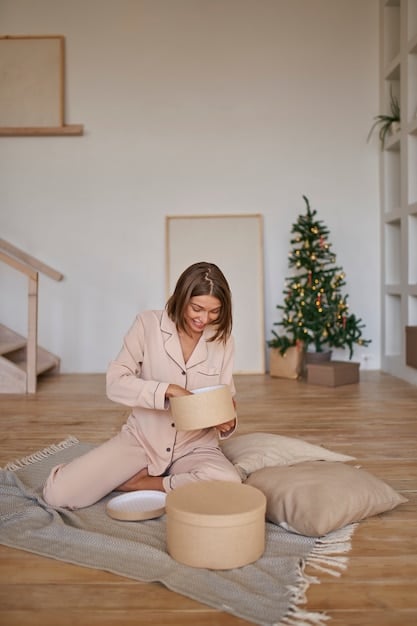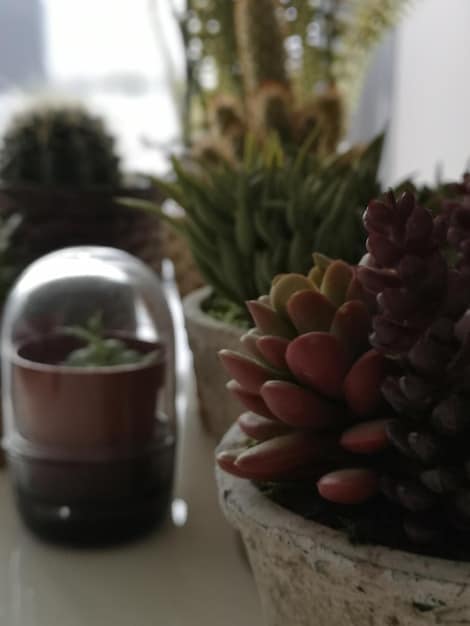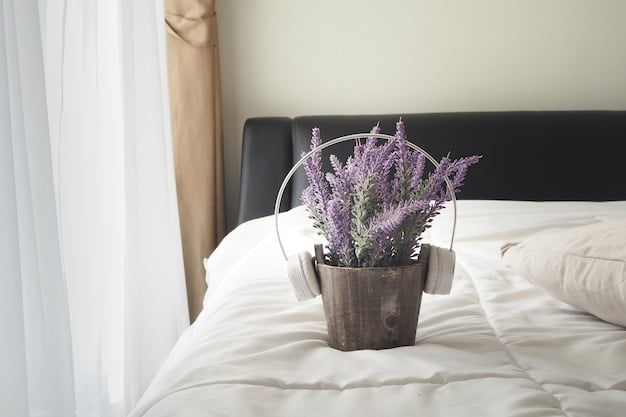Creating a Mindful Home: Design Your Sanctuary

Creating a mindful home involves intentionally designing your living space to promote relaxation, reduce stress, and foster inner peace through decluttering, incorporating natural elements, and establishing dedicated mindful practice areas.
Transforming your home into a sanctuary isn’t just about aesthetics; it’s about nurturing your well-being. By incorporating elements of mindfulness into your living space, you can create a haven that supports relaxation, reduces stress, and fosters inner peace. Let’s explore how you can start creating a mindful home today.
Declutter and Simplify Your Space
The first step in creating a mindful home is to declutter. A cluttered space often leads to a cluttered mind, increasing stress and anxiety. By simplifying your surroundings, you create room for clarity and calm.
Start by going through each room and identifying items that you no longer need, use, or love. Donate, sell, or discard these items responsibly. The goal is to create a space that is free from visual distractions and supports a sense of peace.
The KonMari Method
The KonMari Method, popularized by Marie Kondo, is an effective approach to decluttering. This method involves categorizing your belongings (clothes, books, sentimental items, etc.) and asking yourself if each item “sparks joy.” If it doesn’t, it’s time to let it go.
Creating Storage Solutions
Once you’ve decluttered, focus on organizing what remains. Invest in storage solutions that keep your belongings neatly arranged and out of sight. Baskets, shelves, and cabinets can help you maintain a tidy and organized space.
- Use clear containers to easily identify stored items.
- Label storage containers to stay organized.
- Maximize vertical space with shelves and wall-mounted organizers.
Decluttering isn’t a one-time task; it’s an ongoing process. Make it a habit to regularly assess your belongings and remove anything that no longer serves a purpose. This will help you maintain a mindful and clutter-free home.
By decluttering and simplifying your space, you set the foundation for a more mindful and peaceful living environment. This initial step is crucial for creating a sanctuary that supports your well-being.
Incorporate Natural Elements
Bringing nature indoors is a powerful way to enhance the tranquility of your home. Natural elements have been shown to reduce stress, improve mood, and increase feelings of well-being. Incorporating plants, natural light, and organic materials can transform your living space into a more mindful environment.
Plants are a simple yet effective way to bring nature into your home. They not only purify the air but also add a touch of vibrancy and life to any room.
The Power of Indoor Plants
Different plants offer different benefits. Some popular choices for indoor air purification include spider plants, snake plants, and peace lilies. These plants are easy to care for and can thrive in various indoor conditions.
Maximize Natural Light
Natural light is essential for both physical and mental health. Open your curtains and blinds to allow as much natural light as possible into your home. Consider using sheer curtains to diffuse the light and create a soft, calming ambiance.

- Position plants near windows to maximize sunlight exposure.
- Use mirrors to reflect and amplify natural light.
- Opt for light-colored walls to enhance brightness.
By incorporating natural elements like plants and maximizing natural light, you can create a living space that feels more connected to the natural world. This connection can enhance your sense of peace and promote mindfulness in your daily life.
Bringing the outdoors in not only beautifies your home but also contributes to a healthier and more balanced lifestyle. It’s a simple way to infuse your space with positive energy and foster a sense of calm.
Create a Meditation or Quiet Corner
Having a dedicated space for meditation or quiet reflection can significantly enhance your mindfulness practice. This corner should be a sanctuary where you can retreat to find peace and focus, away from the distractions of daily life.
When designing your meditation corner, choose a spot that feels calm and secluded. This could be a corner of your bedroom, a small nook in your living room, or even a quiet area in your garden.
Designing Your Sanctuary
Start by adding comfortable seating, such as a meditation cushion, a comfortable chair, or a soft rug. Keep the space simple and uncluttered, with minimal distractions. Use soft colors, natural textures, and calming scents to create a serene atmosphere.
Personalizing Your Space
Incorporate items that inspire peace and mindfulness, such as candles, crystals, or a small altar. These personal touches can help you feel more connected to your practice and create a space that resonates with your inner self.
- Use aromatherapy diffusers to introduce calming scents like lavender or chamomile.
- Add soft lighting to create a warm and inviting atmosphere.
- Include a journal and pen for mindful reflection and writing.
Creating a meditation or quiet corner is about designing a space that supports your personal mindfulness practice. It’s a place where you can disconnect from the noise of the outside world and reconnect with your inner self.
By dedicating a specific area to meditation and reflection, you create a physical reminder to prioritize your well-being. This space becomes a constant invitation to pause, breathe, and cultivate mindfulness in your daily life.
Choose Calming Colors and Textures
The colors and textures in your home can have a profound impact on your mood and sense of well-being. Opting for calming colors and natural textures can create a more serene and mindful living environment.
Soft, muted colors like blues, greens, and grays are known for their calming properties. These colors can help reduce stress, promote relaxation, and create a sense of tranquility.
The Psychology of Color
Consider painting your walls in these calming hues, or incorporate them through your furniture, bedding, and decor. Avoid bright, stimulating colors that can create a sense of agitation.
Incorporating Textures
Natural textures like wood, cotton, and linen can add warmth and comfort to your home. Use these materials in your furniture, rugs, and textiles to create a tactile and inviting space.

- Use soft, textured blankets and throws to add coziness to your living spaces.
- Incorporate wooden furniture for a natural and grounding feel.
- Add woven baskets for storage and texture.
By carefully selecting calming colors and natural textures, you can create a home that feels soothing and supportive. These elements work together to create a harmonious and balanced environment that promotes mindfulness and relaxation.
Creating a mindful home is about paying attention to the details that affect your well-being. By choosing colors and textures that resonate with your personal sense of calm, you can transform your living space into a true sanctuary.
Limit Technology and Create Tech-Free Zones
In today’s digital age, it’s essential to create boundaries between technology and your personal space. Limiting technology and establishing tech-free zones in your home can help reduce stress, improve sleep, and enhance mindfulness.
Designate specific areas of your home as tech-free zones, such as the bedroom or dining room. This means no phones, laptops, or televisions in these spaces. Creating tech-free zones encourages relaxation and mindful presence.
Setting Boundaries
Establish specific times of the day when you disconnect from technology. This could be during meals, before bedtime, or during your meditation practice. Setting boundaries helps you regain control over your digital habits.
Mindful Technology Use
When you do use technology, be mindful of how it affects your mood and energy. Avoid mindless scrolling or engaging in activities that increase stress or anxiety. Use technology intentionally and purposefully.
- Charge your devices outside of the bedroom to avoid the temptation of late-night scrolling.
- Use a physical alarm clock instead of your phone to wake up in the morning.
- Engage in digital detoxes regularly to disconnect from technology and reconnect with yourself.
Limiting technology and creating tech-free zones is about reclaiming your attention and presence. By reducing your exposure to digital stimuli, you create space for relaxation, reflection, and meaningful connection.
Creating a mindful home involves being intentional about your relationship with technology. By setting boundaries and practicing mindful use, you can create a living space that supports your well-being and fosters inner peace.
Engage Your Senses Mindfully
Engaging your senses mindfully is a powerful way to ground yourself in the present moment and enhance your connection to your surroundings. This practice involves paying attention to the sights, sounds, smells, tastes, and textures in your home.
Create a sensory-rich environment by incorporating elements that stimulate your senses in a positive way. This could include adding plants with fragrant flowers, playing calming music, or using aromatherapy diffusers with essential oils.
Sensory Experiences
Take time each day to mindfully engage with your senses. Observe the colors and patterns around you, listen to the sounds of nature, smell the aromas of your home, taste your food slowly and deliberately, and feel the textures of the objects you touch.
Creating Sensory Focal Points
Create focal points in your home that engage your senses. This could be a vase of fresh flowers, a collection of smooth stones, or a water fountain with a gentle, soothing sound.
- Use candles with natural scents like lavender or sandalwood to create a calming atmosphere.
- Play nature sounds or ambient music to enhance relaxation.
- Incorporate soft, textured fabrics like silk or velvet to add tactile comfort.
Engaging your senses mindfully is about cultivating a deeper appreciation for the present moment. By paying attention to the sensory experiences in your home, you can enhance your sense of peace, joy, and well-being.
Creating a mindful home involves creating an environment that nourishes your senses and supports your ability to be fully present. This practice transforms your living space into a sanctuary of mindful awareness.
| Key Point | Brief Description |
|---|---|
| 🧹 Decluttering | Remove unnecessary items to clear your mind and space. |
| 🌿 Natural Elements | Incorporate plants, light, and textures to enhance tranquility. |
| 🧘 Quiet Corner | Designate a space for meditation and reflection. |
| 📵 Tech-Free Zones | Limit technology use to reduce stress and improve presence. |
FAQ
▼
Begin by focusing on one area or category at a time. Use the KonMari method: ask yourself if each item sparks joy. If not, thank it and let it go. Donate or discard responsibly.
▼
Spider plants, snake plants, and peace lilies are excellent choices. They are easy to care for and effectively remove toxins from the air, contributing to a healthier home environment.
▼
Choose a quiet spot, add comfortable seating like a cushion or chair, and keep the area uncluttered. Incorporate calming elements like candles, soft lighting, and items that inspire mindfulness.
▼
Soft, muted colors such as blues, greens, and grays are ideal. These colors promote relaxation and reduce stress, creating a tranquil atmosphere in your home.
▼
Designate tech-free zones, like the bedroom, and set specific times to disconnect. Charge devices outside the bedroom and use a physical alarm clock to reduce exposure to screens before bed.
Conclusion
Creating a mindful home is a journey of intentional design aimed at fostering relaxation and inner peace. By decluttering, incorporating natural elements, creating dedicated mindful spaces, and engaging your senses, you can transform your living space into a true sanctuary.





